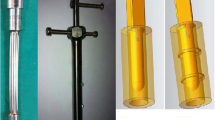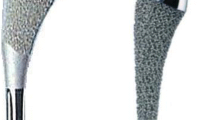Summary
When a cement canal prosthesis is used as the femoral component in total hip replacement (THR), the penetration depth of the bone cement can be varied according to the cement implantation pressure. Using experimental data which give a relation between the pressure applied to the cement at implantation and the resulting shape of the cement layer, a three-dimensional finite element study was performed to calculate the stress distribution at the bone/bone cement interface. The calculations show that the interface stresses increase with increasing depth of penetration by the cement layer. The explanation of this effect is that as the bone cement penetrates further into the cancellous bone, the cancellous bone is stiffened and can no longer act as a soft interposition between cortical bone and bone cement. From these results and from the clinical requirement that as little bone as possible be destroyed in any kind of alloarthroplasty, we conclude that the penetration depth of bone cement into cancellous bone in THR should be minimized to the depth necessary in order to achieve sufficient initial stability of the implant. The results show that a cement-canal prosthesis meets these requirements if a cement implantation pressure of 1.0 bar is used.
Similar content being viewed by others
References
Bannister G (1988) Mechanical failure in the femoral component in total hip replacement. Orthop Clin North Am 19:567–573
Cosmos/M user guide (1990) Structural Research and Analysis Corporation. 1661 Lincoln Bvd, Suite 200, Santa Monica, CA 90401, USA
Draenert K (1988) Forschung und Fortbildung in der Chirurgie des Bewegungsapparates 2. Zur Praxis der Zementverankerung. Art and Science, Munich
Heimkes B, Posel P, Plitz W, Jansson V (1993) Forces acting on the juvenile hip joint in the one-legged stance. J Pediatr Orthop (in press)
Huiskes R, Boeklagen R (1989) Mathematical shape optimization of hip prosthesis design. J Biomech 22:793–804
Jansson V, Kühne J-H, Zimmer M (1992) Die Zement- und Saugkanalprothese — Funktionsprinzip und Ergebnisse experimenteller Untersuchungen eines alternativen Zementierkonzeptes. Orthop Prax 28:470–473
Merck E (1989) Refobacin-Palacos R. Informationsschrift zum Knochenzement Palacos R. Merck, Darmstadt
Pauwels F (1973) Atlas zur Biomechanik der gesunden und kranken Hüfte. Springer, Berlin Heidelberg NewYork
Poss R, Walker P, Spector M, Reilly DT, Robertson DD, Sledge CB (1988) Strategies for improving fixation of femoral components in total hip arthroplasty. Clin Orthop Rel Res 235:181–194
Poss R, Brick GW, Wright RJ, Roberts DW, Sledge CB (1988) The effects of modern cementing techniques on the longevity of total hip arthroplasty. Orthop Clin North Am 19:591–598
Stüwe HP (1969) Einführung in die Werkstoffkunde. Bibliographisches Institut, Mannheim Wien Zürich
Author information
Authors and Affiliations
Rights and permissions
About this article
Cite this article
Jansson, V., Heimkes, B. & Zimmer, M. Stress transfer at the femoral bone/bone cement interface as a function of the cement thickness. Arch Orthop Trauma Surg 112, 65–68 (1993). https://doi.org/10.1007/BF00420256
Received:
Issue Date:
DOI: https://doi.org/10.1007/BF00420256




